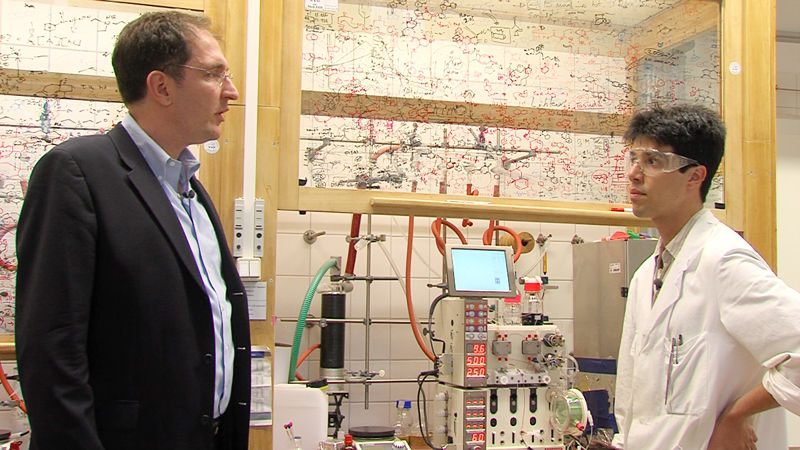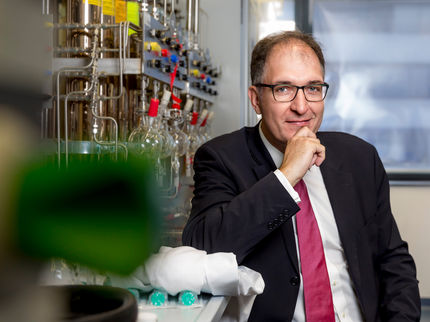Anti-malaria drug synthesised with the help of oxygen and light
In future it should be possible to produce the best anti-malaria drug, artemisinin, more economically and in sufficient volumes for all patients
Advertisement
The most effective anti-malaria drug can now be produced inexpensively and in large quantities. This means that it will be possible to provide medication for the 225 million malaria patients in developing countries at an affordable price. Researchers at the Max Planck Institute of Colloids and Interfaces in Potsdam and the Freie Universität Berlin have developed a very simple process for the synthesis of artemisinin, the active ingredient that pharmaceutical companies could only obtain from plants up to now. The chemists use a waste product from current artemisinin production as their starting substance. This substance can also be produced biotechnologically in yeast, which the scientists convert into the active ingredient using a simple yet very ingenious method.
There is an effective treatment against malaria, but it is not accessible to all of the more than 200 million people worldwide who are affected by the disease. Millions, especially in the developing world, cannot afford the combination drug preparation, which consists mainly of artemisinin. Moreover, the price for the medication varies, as this substance is isolated from sweet wormwood (Artemisia annua) which grows mainly in China and Vietnam, and varies seasonally in its availability. To make the drug affordable for at least some patients in developing countries, the Clinton Foundation, for example, subsidises its cost to the tune of several million dollars per year. Nevertheless, over one million people die of malaria each year because they do not have access to effective drugs.
This may be about to change. Peter H. Seeberger, Director at the Max Planck Institute of Colloids and Interfaces in Potsdam and Professor of Chemistry at the Freie Universität Berlin and his colleague François Lévesque have discovered a very simple way of synthesising the artemisinin molecule, which is known as an anti-malaria drug from traditional Chinese medicine and has an extremely complex chemical structure. “The production of the drug is therefore no longer dependent on obtaining the active ingredient from plants,” says Peter Seeberger.

Prof. Dr. Peter H. Seeberger and Dr. François Lévesque
© MPI of Colloids and Interfaces
Synthesis from a by-product of artemisinin production
As a starting point, the chemists use artemisinic acid – a substance produced as a hitherto unused by-product from the isolation of artemisinin from sweet wormwood, which is produced in volumes ten times greater than the active ingredient itself. Moreover, artemisinic acid can easily be produced in genetically modified yeast as it has a much simpler structure. “We convert the artemisinic acid into artemisinin in a single step,” says Peter Seeberger. “And we have developed a simple apparatus for this process, which enables the production of large volumes of the substance under very controlled conditions.” The only reaction sequence known up to now required several steps, following each of which the intermediate products had to be isolated laboriously – a method that was far too expensive to offer as a viable alternative to the production of the drug from plants.
The striking simplification of artemisinin synthesis required not only a keen sense for an elegant combination of the correct partial reactions to enable the process to take place in a single step; it also took a degree of courage, as the chemists departed from the paths typically taken by industry up to now. The effect of the molecule, which not only targets malaria but possibly also other infections and even breast cancer, is due to, among other things, a very reactive chemical group formed by two neighbouring oxygen atoms – which chemists refer to as an endoperoxide. Peter Seeberger and François Lévesque use photochemistry to incorporate this structural element into the artemisinic acid. Ultraviolet light converts oxygen into a form that can react with molecules to form peroxides.
800 photoreactors should suffice to cover the global requirement for artemisinin
“Photochemistry is a simple and cost-effective method. However, the pharmaceutical industry has not used it to date because it was so difficult to control and implement on a large scale,” explains Peter Seeberger. In the large reaction vessels with which industrial manufacturers work, flashes of light do not penetrate deeply enough from outside and the reactive form of oxygen is not produced in sufficient volumes. The Potsdam-based scientists have succeeded in resolving this problem using an ingenious trick: They channel the reaction mixture containing all of the required ingredients through a thin tube that they have wrapped around a UV lamp. In this structure, the light penetrates the entire reaction medium and triggers the chemical conversion process with optimum efficiency.
“The fact that we do not carry out the synthesis as a one-pot reaction in a single vessel, but in a continuous-flow reactor enables us to define the reaction conditions down to the last detail,” explains Peter Seeberger. After just four and a half minutes a solution flows out of the tube, in which 40 percent of the artemisinic acid has become artemisinin. “We assume that 800 of our simple photoreactors would suffice to cover the global requirement for artemisinin,” says Peter Seeberger. And it could all happen very quickly. Peter Seeberger estimates that the innovative synthesis process could be ready for technical use in a matter of six months. This would alleviate the global shortage of artemisinin and exert considerable downward pressure on the price of the associated drugs.


















































